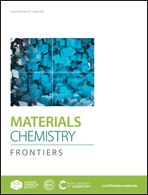Cucurbit[6]uril-based carbon dots for recognizing l-tryptophan and capecitabine†
Abstract
Fluorescent nitrogen and fluorine doped carbon dots (CDs) were prepared by a hydrothermal method using levofloxacin (LVFX) and cucurbit[6]uril (Q[6]) as the nitrogen and carbon sources, respectively. Decomposition of LVFX occurred at elevated temperature affording N,N′-desethylene levofloxacin hydrochloride (N,N′-DLH). The crystal structure of the resulting inclusion complex N,N′-DLH@Q[6]·[CdCl4]2(H3O)·9H2O was determined, where N,N′-DLH is protonated on each of the terminal nitrogens and the quinone functionality is a quinol which forms an intramolecular hydrogen bond to the carboxylic acid. The synthesized N,N′-DLH containing Q[6]-CDs emitted intense blue fluorescence with high photostability and exhibited stability at high ionic strength. In particular, the original rigid macrocyclic skeletons of these hosts were retained during the fabrication process, which helps in uniquely distinguishing them from other reported CDs. Meanwhile, the performance of the Q[6]-CDs was characterized using fluorescence and NMR spectroscopies. Subsequently, using the obtained Q[6]-CDs, an efficient sensing method for L-tryptophan (L-Trp) and capecitabine (CAP) has been developed based on macrocyclic host–guest chemistry. Under applicable conditions, the detection limits for L-Trp and CAP were calculated to be 5.13 × 10−8 M and 1.48 × 10−8 M, respectively.
![Graphical abstract: Cucurbit[6]uril-based carbon dots for recognizing l-tryptophan and capecitabine](/en/Image/Get?imageInfo.ImageType=GA&imageInfo.ImageIdentifier.ManuscriptID=D2QM00589A&imageInfo.ImageIdentifier.Year=2022)


 Please wait while we load your content...
Please wait while we load your content...